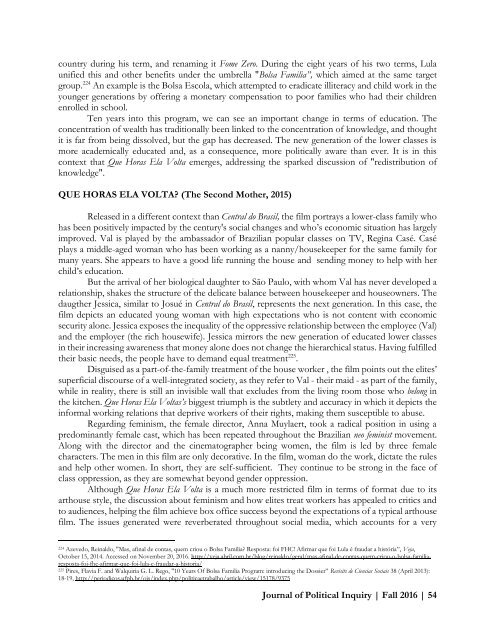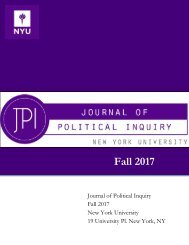Fall2016_Final
Create successful ePaper yourself
Turn your PDF publications into a flip-book with our unique Google optimized e-Paper software.
country during his term, and renaming it Fome Zero. During the eight years of his two terms, Lula<br />
unified this and other benefits under the umbrella "Bolsa Familia”, which aimed at the same target<br />
group. 224 An example is the Bolsa Escola, which attempted to eradicate illiteracy and child work in the<br />
younger generations by offering a monetary compensation to poor families who had their children<br />
enrolled in school.<br />
Ten years into this program, we can see an important change in terms of education. The<br />
concentration of wealth has traditionally been linked to the concentration of knowledge, and thought<br />
it is far from being dissolved, but the gap has decreased. The new generation of the lower classes is<br />
more academically educated and, as a consequence, more politically aware than ever. It is in this<br />
context that Que Horas Ela Volta emerges, addressing the sparked discussion of "redistribution of<br />
knowledge".<br />
QUE HORAS ELA VOLTA? (The Second Mother, 2015)<br />
Released in a different context than Central do Brasil, the film portrays a lower-class family who<br />
has been positively impacted by the century's social changes and who’s economic situation has largely<br />
improved. Val is played by the ambassador of Brazilian popular classes on TV, Regina Casé. Casé<br />
plays a middle-aged woman who has been working as a nanny/housekeeper for the same family for<br />
many years. She appears to have a good life running the house and sending money to help with her<br />
child’s education.<br />
But the arrival of her biological daughter to São Paulo, with whom Val has never developed a<br />
relationship, shakes the structure of the delicate balance between housekeeper and houseowners. The<br />
daugther Jessica, similar to Josué in Central do Brasil, represents the next generation. In this case, the<br />
film depicts an educated young woman with high expectations who is not content with economic<br />
security alone. Jessica exposes the inequality of the oppressive relationship between the employee (Val)<br />
and the employer (the rich housewife). Jessica mirrors the new generation of educated lower classes<br />
in their increasing awareness that money alone does not change the hierarchical status. Having fulfilled<br />
their basic needs, the people have to demand equal treatment 225 .<br />
Disguised as a part-of-the-family treatment of the house worker , the film points out the elites’<br />
superficial discourse of a well-integrated society, as they refer to Val - their maid - as part of the family,<br />
while in reality, there is still an invisible wall that excludes from the living room those who belong in<br />
the kitchen. Que Horas Ela Voltas’s biggest triumph is the subtlety and accuracy in which it depicts the<br />
informal working relations that deprive workers of their rights, making them susceptible to abuse.<br />
Regarding feminism, the female director, Anna Muylaert, took a radical position in using a<br />
predominantly female cast, which has been repeated throughout the Brazilian neo feminist movement.<br />
Along with the director and the cinematographer being women, the film is led by three female<br />
characters. The men in this film are only decorative. In the film, woman do the work, dictate the rules<br />
and help other women. In short, they are self-sufficient. They continue to be strong in the face of<br />
class oppression, as they are somewhat beyond gender oppression.<br />
Although Que Horas Ela Volta is a much more restricted film in terms of format due to its<br />
arthouse style, the discussion about feminism and how elites treat workers has appealed to critics and<br />
to audiences, helping the film achieve box office success beyond the expectations of a typical arthouse<br />
film. The issues generated were reverberated throughout social media, which accounts for a very<br />
224<br />
Azevedo, Reinaldo, "Mas, afinal de contas, quem criou o Bolsa Família? Resposta: foi FHC! Afirmar que foi Lula é fraudar a história”, Veja,<br />
October 15, 2014. Accessed on November 20, 2016. http://veja.abril.com.br/blog/reinaldo/geral/mas-afinal-de-contas-quem-criou-o-bolsa-familiaresposta-foi-fhc-afirmar-que-foi-lula-e-fraudar-a-historia/<br />
225<br />
Pires, Flavia F. and Walquiria G. L. Rego, "10 Years Of Bolsa Familia Program: introducing the Dossier” Revisits de Ciencias Sociais 38 (April 2013):<br />
18-19, http://periodicos.ufpb.br/ojs/index.php/politicaetrabalho/article/view/15178/9375<br />
Journal of Political Inquiry | Fall 2016 | 54
















